Contrary to popular belief, cats don’t see the world in black and white; they perceive colors differently than humans.
This guide delves into the nuances of feline color vision, exploring the science behind what colors cats can see and why it matters.
Let’s uncover the vibrant world from a cat’s perspective, enriching our relationship with these fascinating companions.
KEY TAKEAWAYS
- Cats have dichromatic vision, primarily seeing shades of blue and green, influencing their interaction with the world.
- The abundance of rod cells in cats’ eyes enhances their sensitivity to light and motion, aiding their nocturnal prowess.
- Cats’ color vision is adapted to their survival needs, prioritizing features crucial for their nocturnal activities and hunting behaviors.
- Understanding cats’ color vision can help owners select toys and accessories that are more appealing and engaging to their pets.
- Brightness and contrast significantly affect cats’ visual engagement, often more than the color itself.
- The design of a cat’s play environment, including toy colors and contrasts, can greatly impact their playtime behavior and engagement.
- Individual age, breed, and health variations can influence a cat’s color perception and preferences.
- Recognizing and adapting to each cat’s unique color vision preferences can deepen the bond between cats and their owners.
How Cats See the World

The Science Behind Cat Vision
Cats’ vision is a marvel of nature, finely tuned to their lifestyle as nocturnal hunters. Unlike humans, who possess trichromatic vision enabling the perception of a wide color spectrum, cats experience the world differently:
Cats have dichromatic vision, meaning they have two types of cone cells in their eyes. These cones are primarily sensitive to blue and green wavelengths, resulting in a more limited color palette perfectly adapted to their needs.
Key Features of Cat Vision:
- Rod Cell Abundance: A significant aspect of cats’ vision is their abundance of rod cells, which are:
- Incredibly sensitive to light and motion.
- Essential for cats’ prowess in low-light conditions, allowing them to detect slight movements in the dark—crucial for their predatory behaviors.
- Adaptation Over Spectrum: While cats might not appreciate the full spectrum of colors that humans do, their vision system is sophisticated and highly adapted:
- Prioritizes features important for survival and daily activities.
- Enhances their nocturnal abilities, aiding in play and hunting behaviors.
Understanding the intricacies of cat vision helps cat owners appreciate the natural inclinations of their pets.
This knowledge can deepen the bond between cats and their owners, providing insights into their nocturnal playfulness and preferences for certain toys and movements.
Colors Cats Can See
Exploring the feline color spectrum reveals that cats perceive the world differently than humans.
To illustrate these differences and their implications, let’s consider the following table:
| Feature | Cats | Humans |
|---|---|---|
| Color Vision Type | Dichromatic | Trichromatic |
| Primary Colors Seen | Shades of blue and green | Full color spectrum (including reds) |
| Perception of Reds | Reds appear as shades of gray | Vivid reds and pinks |
| World View | Similar to dawn or dusk, more muted colors | Vivid and diverse color palette |
| Implications for Toys/Accessories | Prefer blues and greens, influenced by brightness and contrast | Color choices can be more varied |
This table highlights the key differences in color perception between cats and humans.
It emphasizes the importance of selecting toys and accessories in shades cats can more readily see and interact with.
Understanding these differences can help cat owners make informed choices that cater to their pets’ specific sensory experiences, enhancing their engagement and overall well-being.
Cats’ Favorite Colors and Their Preferences

Preferred Colors for Feline Friends
Cats’ attraction to specific colors, particularly blues and greens, is more than just a matter of vision capability; it’s deeply rooted in their instincts and natural environment.
These colors are prevalent in their ancestral hunting grounds, from the azure skies to the verdant landscapes, which might explain their inclination towards these hues.
This preference can be observed in their behavior, often showing more interest in toys and accessories that mimic the shades of their natural prey or surroundings.
The Role of Brightness and Contrast
Cats’ visual engagement goes beyond color, with brightness and contrast playing pivotal roles:
Key Insights into Brightness and Contrast:
- Sensitivity to Light and Contrast: Cats can detect variations in light intensity and contrasting patterns. This capability is vital for spotting prey and navigating their natural environment.
- Attraction to Contrast: Cats are often more attracted to objects that stand out against their background due to high contrast levels. For example, a dark blue toy against a light blue background might be more captivating for a cat than a red toy against a green background.
Practical Advice for Cat Owners:
Understanding the significance of brightness and contrast can greatly benefit cat owners in enhancing their pets’ living spaces:
- Selecting the Right Items: When choosing toys and accessories, consider items that match cats’ color vision preferences and offer significant brightness and contrast. This combination can lead to a more engaging experience for the cat.
- Designing Engaging Spaces: This understanding extends to selecting bedding, climbing structures, and even the colors of the walls in areas where cats spend a lot of time. Incorporating elements with high contrast can stimulate a cat’s interest and encourage more active interaction with their environment.
Incorporating these insights into the selection of toys, accessories, and environmental design can significantly enrich a cat’s daily life, making their surroundings more intriguing and enjoyable.
How Cats’ Color Vision Affects Their Playtime
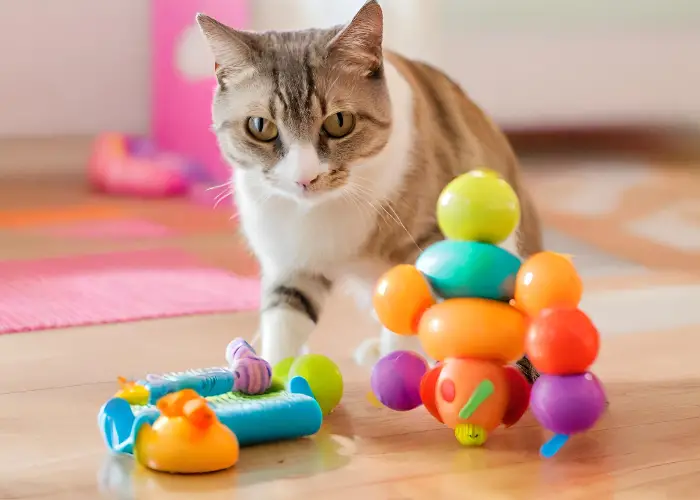
Cats’ unique color vision significantly shapes their playtime, influencing their preferences and interactions with toys and their environment.
Understanding this can help cat owners enhance their furry companions’ play experiences.
Selecting Toys That Appeal to Cats
- Color Preferences: Given cats’ dichromatic vision, toys in shades of blue and green are more likely to catch their attention. These colors mimic the hues they would naturally perceive in their environment, making such toys more interesting.
- Importance of Contrast: Beyond color, the contrast between a toy and its background can stimulate playtime. Toys that stand out sharply against their surroundings are more visible and enticing to cats, encouraging them to engage in play.
Playtime Behavior and Engagement
- Stimulating Natural Instincts: Toys that align with cats’ color vision and contrast sensitivity can stimulate their natural hunting instincts. Movements against a contrasting background can mimic the motion of prey, sparking their interest and prompting playful pouncing and chasing behaviors.
- Enhanced Interaction: Cats are likelier to interact with toys they can easily see and distinguish. Owners can ensure longer and more fulfilling play sessions by choosing toys that cater to their visual capabilities, contributing to their pet’s physical and mental well-being.
Environmental Considerations
- Creating an Engaging Space: The play area’s design can also impact how cats engage during playtime. Using mats or play surfaces in colors that contrast with the toys can make the play environment more visually engaging for cats, enhancing their overall play experience.
- Adapting to Individual Preferences: Recognizing that each cat may have unique preferences, owners can experiment with different colors and contrasts in toys and play environments to discover what best motivates their cat’s playfulness.
Incorporating these insights into playtime can significantly enrich a cat’s daily activities, making them more engaging and closely aligned with their natural behaviors and preferences.
By thoughtfully selecting toys and designing play spaces with cats’ color vision in mind, owners can foster a more stimulating and enjoyable environment for their beloved pets.
Practical Applications for Cat Owners
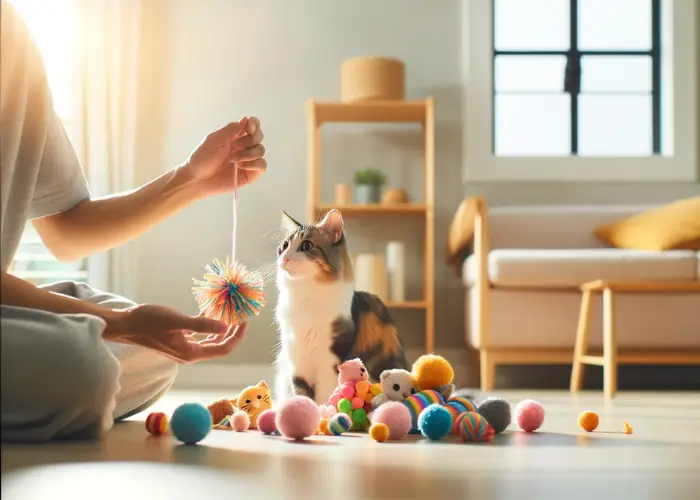
Selecting the Right Toys and Accessories
Choosing toys and accessories that align with cats’ color vision can significantly enhance their playtime and interaction.
Given cats’ propensity for blues and greens, selecting items within this spectrum can naturally draw their attention.
But it’s not just about color; incorporating elements of brightness and contrast, as well as varying textures and shapes, can stimulate their predatory instincts and encourage more active engagement.
For instance, a toy mouse in a shade of blue with contrasting patterns can be more enticing and lead to prolonged periods of play.
Enhancing Your Cat’s Environment
Creating a stimulating and comfortable environment for cats extends beyond toys.
Considering their color vision and preferences can inform decisions about bedding, climbing structures, and even wall colors in spaces where cats spend a lot of time.
Combining shades of blue and green in these elements with high-contrast designs can make an environment more appealing and mentally stimulating for cats.
Additionally, ensuring ample natural light can enhance the vibrancy of these colors, further enriching your cat’s living space.
This approach caters to their visual preferences and contributes to their overall well-being, providing a comforting and engaging environment.
By thoughtfully selecting items and designing spaces with cats’ color vision in mind, owners can foster a deeper connection with their pets, understanding their needs and preferences more intuitively.
Individual Variations in Color Perception
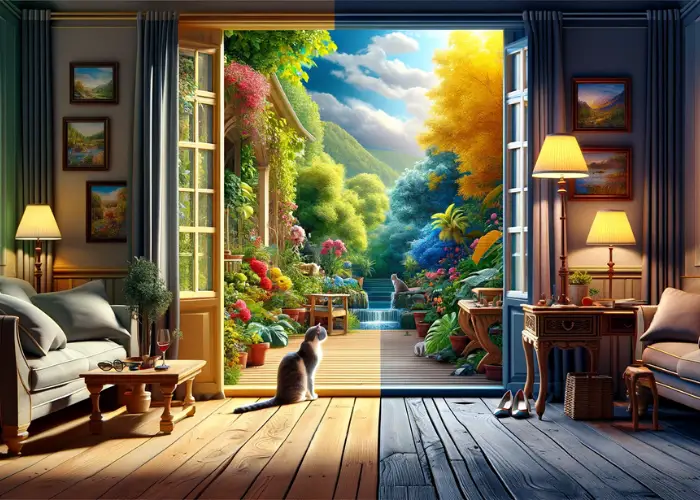
While the general principles of cat color vision apply broadly, individual variations can influence how each cat perceives colors. Age, breed, and health can all shape a cat’s color perception and preferences.
- Age: Just like humans, cats can experience changes in vision as they age. Older cats may have diminished color perception, affecting their interaction with colored objects and their environment.
- Breed: Certain cat breeds may have slight differences in vision capabilities, including color perception. For example, breeds predisposed to specific eye conditions might exhibit variations in how they perceive colors.
- Health: Eye health is crucial for color vision. Conditions like cataracts or degenerative eye diseases can impact the clarity and range of colors a cat can see.
Understanding these individual differences is essential for cat owners, as it emphasizes the need to observe and adapt to their cat’s preferences and behaviors.
Not all cats will react the same way to a particular color or pattern, so a degree of trial and observation is recommended to discover what works best for each pet.
FAQs on Cats and Color Vision
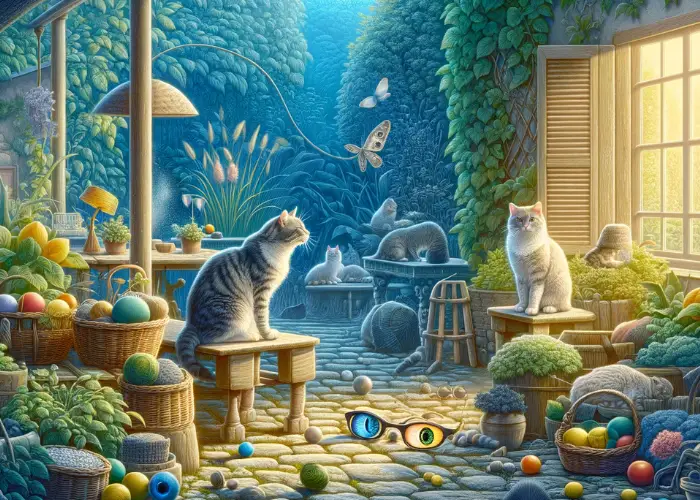
What colors do cats see the best?
Cats see shades of blue and green the best due to their dichromatic vision. These colors are more vivid and distinguishable in their field of vision, aligning with the wavelengths their eyes are most sensitive to.
What are the most calming colors for cats?
Calming colors for cats include soft blues and greens, which align with their color vision preferences. These colors can create a serene environment, potentially reducing stress and promoting relaxation.
What color do cats like to sleep in?
While cats don’t have a specific color preference for sleeping areas, they prefer comfortable, secure spots. Soft, neutral colors like light blues or greens might create a calming space conducive to rest.
Can cats see in total darkness?
Cats cannot see in complete darkness, but their eyes adapt to low-light conditions. They require minimal light to see effectively, thanks to their large pupils and reflective layer behind the retina, enhancing night vision.
Conclusion
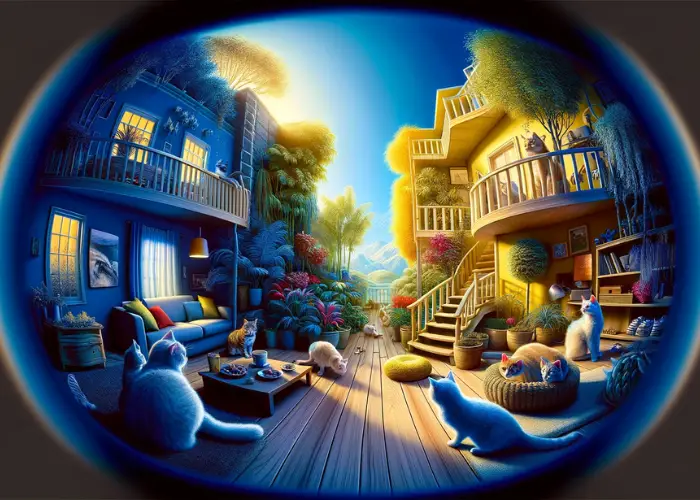
Understanding cats’ color vision enriches our perspective on their world and allows us to tailor their environment better to suit their needs.
From selecting the right toys to enhancing their living spaces, considering how cats perceive colors can make a significant difference in their well-being and our relationship with them.
As we’ve seen, while cats may not see the rainbow as humans do, their vision is perfectly adapted to their lifestyle, with individual variations adding another layer of complexity to their colorful world.
References
- Daw, N. W., & Pearlman, A. L. (1970). Cat colour vision: Evidence for more than one cone process. The Journal of Physiology, 211(1), 125-137. https://doi.org/10.1113/jphysiol.1970.sp009270


